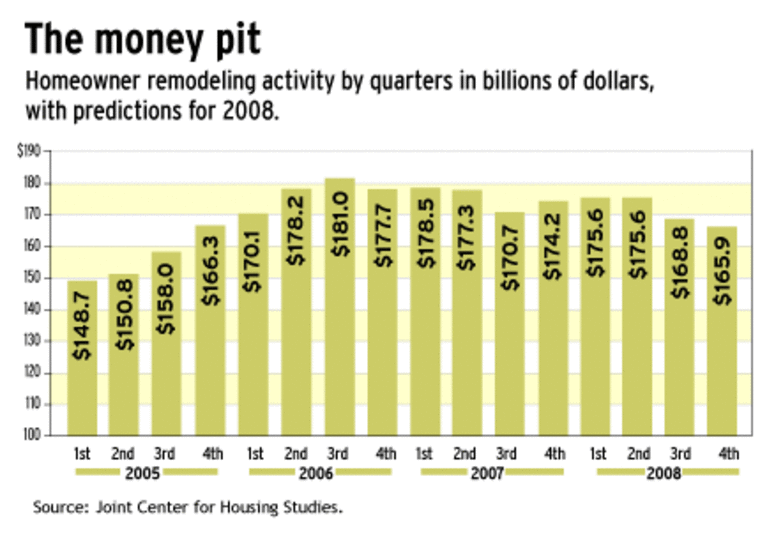Chris Morello, 33, worked nonstop during 2006 and 2007 as a remodeling contractor in the San Jose, Calif., area. His project pipeline was healthy as 2008 dawned: He’d taken on a $150,000 job revamping a kitchen and two bathrooms for one homeowner and a separate $85,000 project. The gigs represented six months’ income.
Fast forward to May, though, and Morello says both projects fell through — one homeowner suffered a lost job and one got cold feet. Morello is essentially unemployed — and making postings to contractor chat boards saying he needs work. Instead of leading a crew through $235,000 worth of projects, he worked solo on handyman gigs — repairing fences and installing insulation.
“The past six months have really dropped off. People are putting projects on hold,” he says. “For me, it means no work.”
In the case of the curtailed $85,000 project, Morello may end up getting the work after all. But the homeowner now wants to renegotiate pricing — at a time when gas prices and Morello’s construction material costs are both rising. He says he’s recently lost a few bids to unlicensed contractors pitching lowball rates just to get gigs.
“Something weird is going on out there,” he says.
Bouncing back ... in 2012
Morello’s right. The remodeling industry responds to the broader real estate and housing markets, and the downturn in the housing industry has dragged down the remodeling sector with it. Last week two economists said business in the remodeling sector likely will remain slow at least until 2009.
David Seiders, chief economist for the National Association of Home Builders, estimates the remodeling business will fall 7 percent in 2008, coming on the heels of a 4 percent decline in 2007. A slight improvement is expected next year, but the market won’t return to the peak levels of 2006 until 2012, he estimated.
“We’re clearly in an economic slowdown,” Seiders said.
The NAHB's remodeling market index, tracked quarterly, indicates that remodeling professionals expect continued weakness this quarter.
“The downward trend in the expectations is particularly striking,” he said.
As Morello learned, there are a variety of factors at play. Sinking or stagnant home values in many markets paired with tougher financing criteria reduce homeowners’ motivation to get work done in some markets, Seiders said. Sure, homeowners will do routine maintenance and repair work — mending or upgrading crucial home features like windows — but there will be fewer blowout kitchen remodels.
Location, location, location
Of course, as with all matters real estate, some locales are hit harder than others. Kermit Baker, senior research fellow at Harvard University’s Joint Center for Housing Studies, who oversees remodeling research for the organization, sees tremendous variation among cities. That’s because remodeling trends track local market data on home sales levels and home prices.
Because sellers often remodel before putting a home on the market, and buyers remodel to customize their new property, home sales activity is one indicator of upcoming demand for remodels. Because those who remodel often use equity to finance the work, home price gains or at least stability help boost remodeling activity. If home values are sliding, both borrowing potential and return-on-investment potential from do, too.
Indeed San Jose, where Morello’s workload is idling, is among the more difficult markets because sales activity is so slow. Sales volume over the past 12 months plunged 61 percent, according to data compiled by Baker.
The return on investment for remodeling projects has declined over the past five years, according to data Baker cited from Remodeling Magazine and the National Association of Realtors. Just five years ago, during better times in the housing market, remodelers recouped about 82.5 percent of their projects’ expenses at resale, but by 2007 they only got 70 percent, according to the NAR/Remodeling data.
But there are bright spots around the country — markets where home prices continue to increase or maybe not decrease that much, Baker says. These include Portland, Seattle and many Texas cities where buying and selling activity are brisk or at least not suffering like markets in California, Florida and the Southwest.
Making do in Midwest, Southwest
Even in stronger markets contractors are seeing a slowdown, but they say they’re still busy. In Milwaukee, for example, home sales volume is down about 7 percent. But for Dean Herriges, president of Milwaukee-area contractor Urban Herriges & Sons, the big projects that have vanished elsewhere keep on coming.
During boom times, when homes sold quickly, Herriges would encounter “ROI remodelers” — those seeking a return on investment who wanted to hire his company for projects that would make their home more marketable. With the market softer, clients are looking for projects to improve their quality of life instead.
“I haven’t had anyone ask me over the past six to eight months if they should remodel or relocate, vs. if they should remodel just to sell and profit,” he says.
Lonny Rutherford, president of Legacy Construction in Farmington, N.M., says his team is “holding our own” during a changed market, where his “gold-plated” clients with big budgets now struggle to get financing or hesitate to sign contracts.
While high-end jobs are fewer, he says, there are always clients who want “green” projects that can lower energy expenses. Seniors, too, are now hiring contractors to outfit their homes so they can age in place rather than move to a special facility, he says.
What does the remodeling slowdown mean for consumers? For those who can get financing and have a little equity, it means that the contractors once notorious for not returning phone calls now respond — and promptly.
“I don’t plan to leave the business,” says Morello. “This is what I do.”
